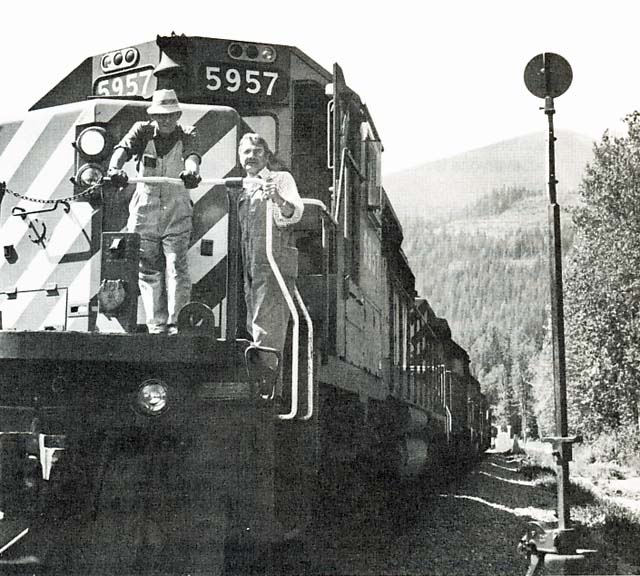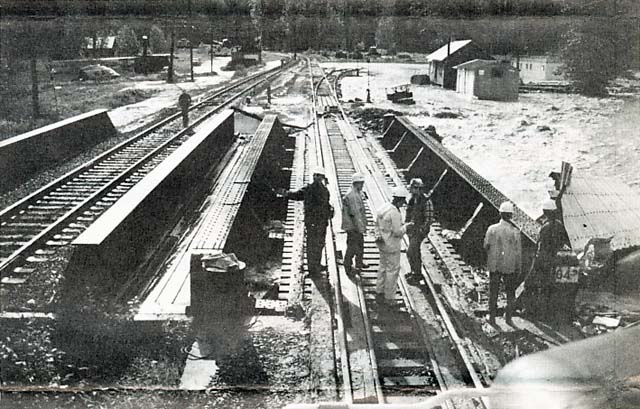|

Volume 13
Number 14
October 26, 1983
|
|
 |


Called to Assist: Pusher Locomotive Engineers Bob Bruce (left) and Nick Planden are seen here on the leading
pusher unit, number
5957.
Railway's Trains Conquer the Selkirks
with Help of Pushers
Stories and photos by Jane Mudry
Rogers Pusher Station - Piloting a 108-car unit train through the Selkirk Mountain Range to a Pacific port would be a difficult task at
best without the assistance of railwaymen like Nick Planden and Bob Bruce.
The veterans are among six locomotive engineers who operate the railway's powerful pusher locomotives at this lonely outpost, 60 miles (96.6
kilometres) east of Revelstoke.
They're on call 24 hours a day and their stay here can stretch 16 or 17 days at a time.
"When we get called to assist a train we drop everything", says Nick, who has been with CP Rail for 41 years, the last several of which
have been spent on the pushers. "But don't worry, no one goes hungry or without sleep".
A cook, a cook's helper, a signal maintainer, and a camp attendant are also stationed here to see that all the basic amenities are
provided.
Nick says the number of miles a locomotive engineer clocks determines when he can go home.
"As soon as we have our 3,800 miles (6,115 kilometres), our rotation is finished and we go home for a week or two. It varies.
For Nick, home is Revelstoke, but other locomotive engineers come from as far away as Vancouver and Penticton to work here.
On the day of my interview, Nickand Bob were called upon to assist a grain train heading for the Burrard Inlet in Vancouver.
All six 3,000-horsepower SD40-2 diesel locomotives at the station were needed to push the consist up the 2.2 percent grade to Stoney Creek, nine
miles (14.5 kilometres) away.
ASSISTING
The pusher locomotives were moved out of a wye and cut into the train about a quarter of the way in from the caboose.
They would assist the train's two lead locomotives and three robot diesels.
The consist pulled out of the station at 10:45 a.m. and it took 45 minutes at a slow 12 miles (19 kilometres) an hour to make the short
journey.
When completed, the pusher locomotives were cut out and returned to Rogers to wait for the next train.
At present, about 90 percent of the west-bound trains that travel through here require pusher locomotives to make it up the grade.
It's more than enough to keep men like Nick and Bob on the move.
In the early days of railroading on the Mountain subdivision, pushers were needed at Revelstoke, Albert Canyon, Rogers Pass, Beaversmouth, and
Golden.
However, improvements such as reducing the grades, diverting the rails along easier routes, and the building of the Connaught Tunnel have
eliminated all but the Rogers Pusher Station, and the fate of this operation has also been decided.
The $660 million Rogers Pass Improvement Project, which will see the building of two tunnels, 11 new bridges, a grade of less than one percent,
and numerous stretches of double tracking through the Mountain subdivision, has sounded the death knell for CP Rail's remaining pusher
operation.
And when this major project is completed in an expected four years, railwaymen like Nick and Bob will have their pick of the jobs, because only
the most senior of locomotive engineers get to work at this important railway outpost.

Assessing Damages: Division Engineer Karl Jansens and former Assistant Superintendent Neil Foot are among the railwaymen assessing
the damages at mileage 104.9 caused by heavy rains and flooding in July.
This CP Rail News article is copyright 1983 by the Canadian Pacific Railway and is
reprinted here with their permission. All photographs, logos, and trademarks are the property of the Canadian Pacific Railway Company.
|


